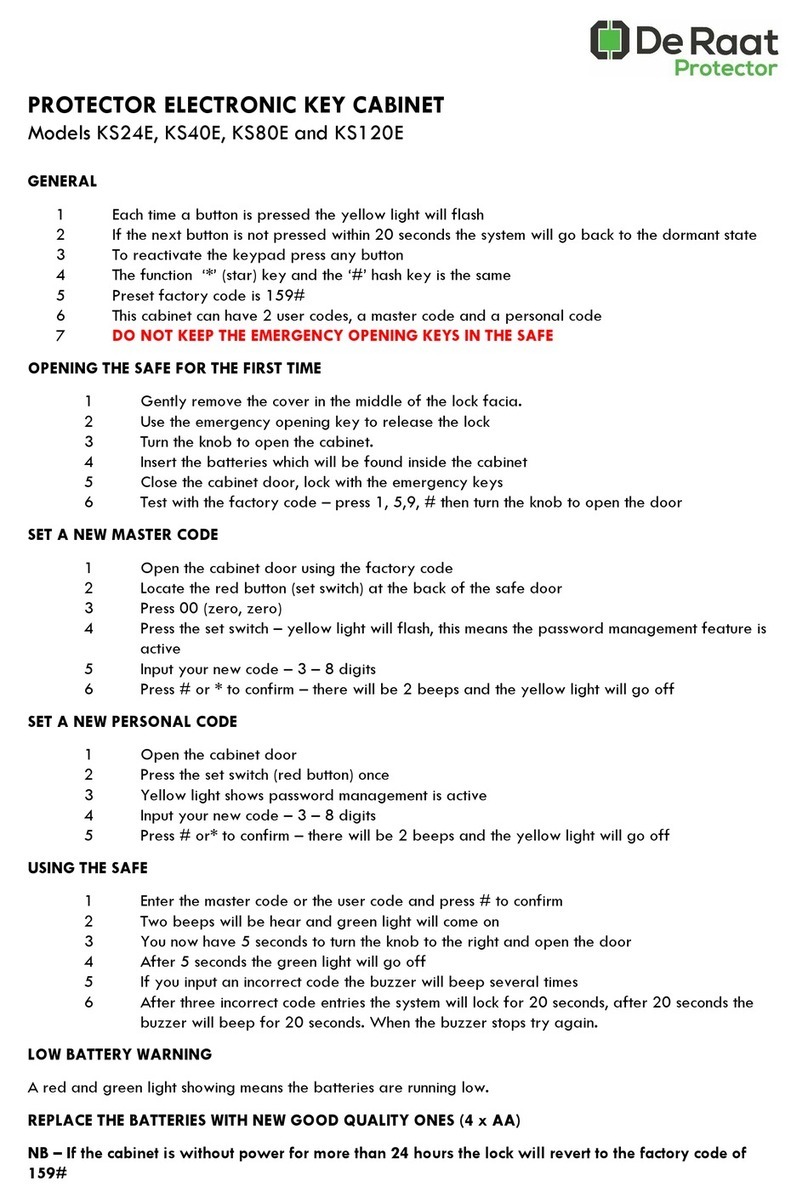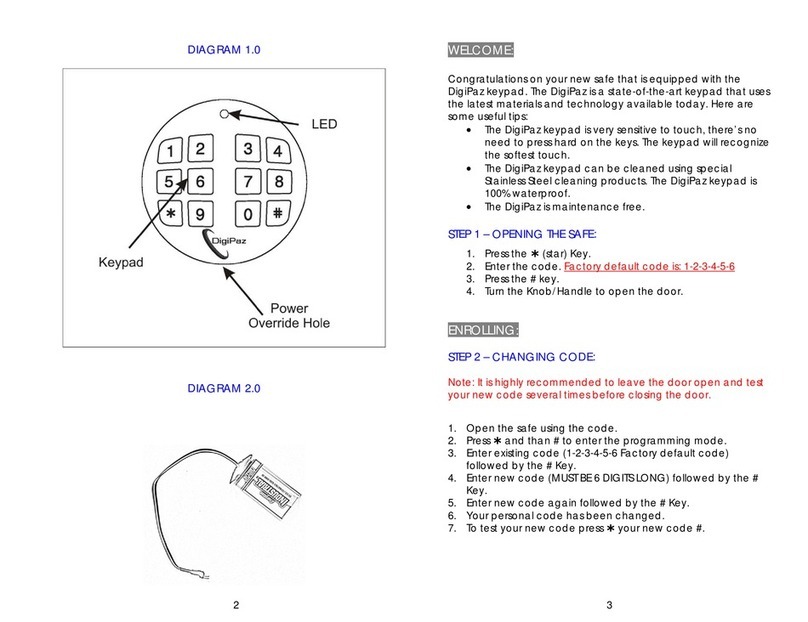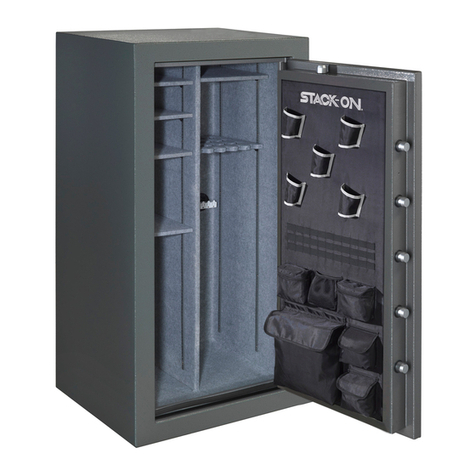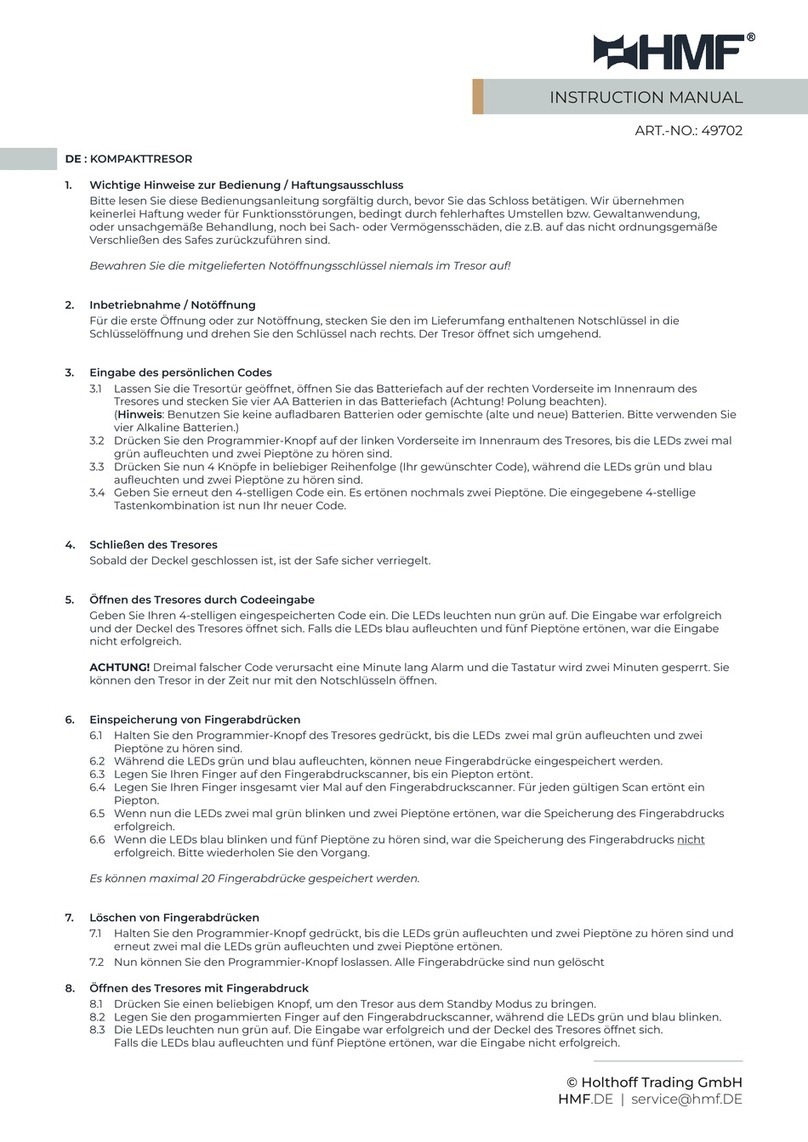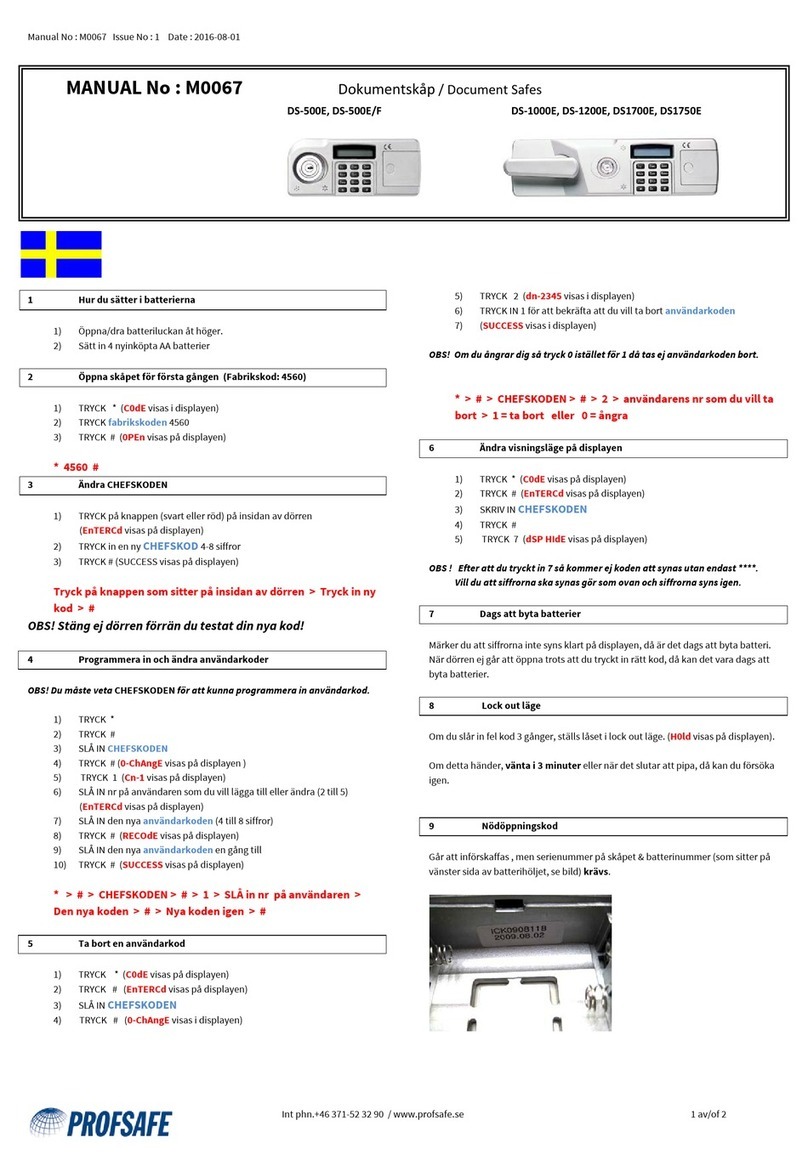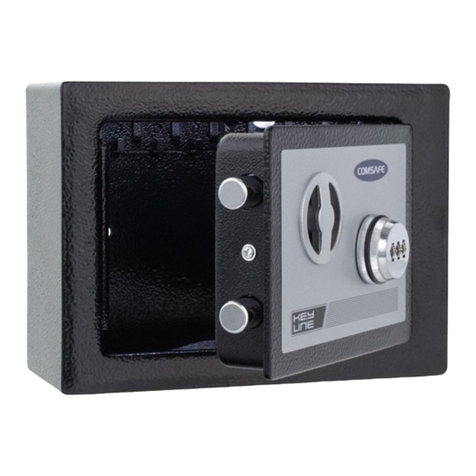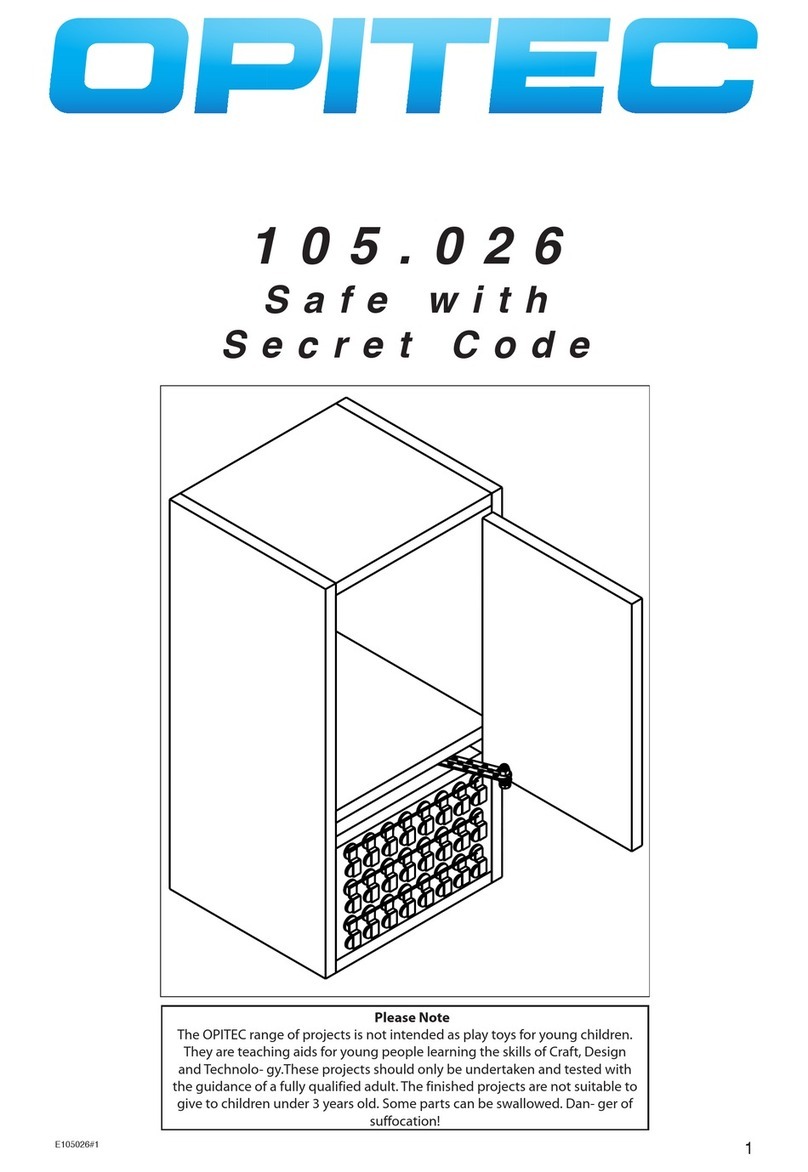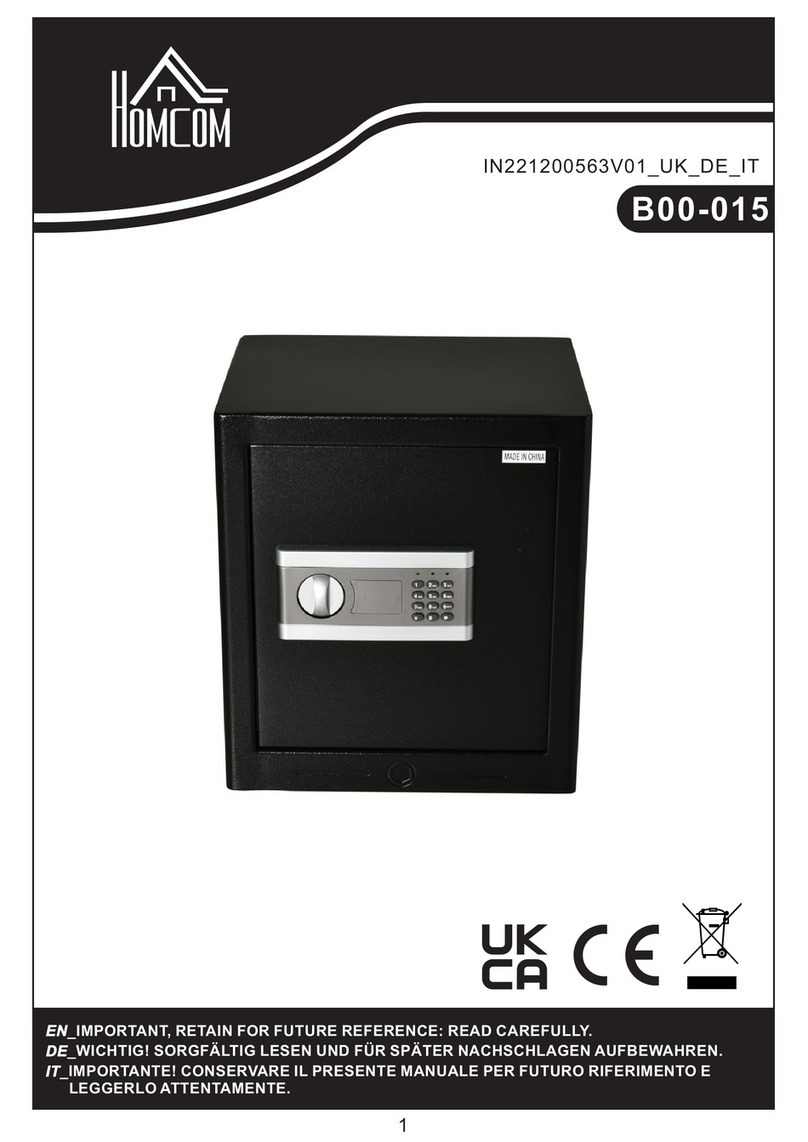De Raat Code combi B 30 User manual

Intructions Code combi B 30
• The enclosed inspecon key allows full access to the lock
and its conguraons even in case of code loss. Thus, it is at
the highest hierarchy level of the lock. Therefore, it must be
stored in a safe place, but not in the secure storage unit.
• For security reasons programming and baery replacement
should always be performed and then tested with the
secure storage unit open.
• Every correct key stroke recognized by the lock is conrmed
by an acousc signal.
• You have max. 10 sec. for each individual key stroke. If no
key is pressed during these 10 seconds, the electronics
shuts down automacally. Uncompleted operaons must
be restarted aer that. The only excepons to this are the
code status query and the programming mode with 30
seconds response me unl automac shutdown.
• Code inputs resp. all further funcons (e.g. programming
operaons) can be cancelled unl the last key stroke by
pressing the key twice.
• Do not use for your code personal or similar known data
which are easy to nd out.
• If the set code(s) is(are) not available, the lock can be
opened or reset using the enclosed inspecon key.
• The lock is designed for use in the temperature range from
+10° C to +50° C and with humidity of 30% to 80%
(noncondensing).
• The lock must never be greased with or contact other
lubricants or aggressive liquids, it must be cleaned only
with a moist cloth only (no aggressive cleaning agents).
Code combi B 30
Important notes
• Never open the lock housing. Dismount the ng only for
baery replacement and perform it strictly according to the
specicaons of these operang instrucons. Avoid touching
electronic components. Otherwise, you endanger the
funcons of the lock and loose the right for the warranty
claims.
• During start-up the serial number of the input unit is saved
in the audit memory of the lock. Replacement of the input
unit is also registered by means of an entry in the audit
memory of the lock.
• For every descripon of operaon or programming
processes hereaer it is assumed that the lock and the input
unit are in the basic state. Basic state means that the lock is
closed (the bolt lock is extended) and the lock electronics is
switched o. If you are not sure, whether the lock is closed,
check if the rotary knob can be turned counterclockwise. To
ensure that the lock is not in a running programming
process, you can press the key twice to cancel it.
• Upon delivery the lock is set by Kaba Mauer GmbH to the
assembler coder "1". For security reasons acvate the
master code with your individual code immediately in order
to deacvate the assembler code. The assembler code is
meant only for lock mounng, it is not suitable for further
permanent use.
• Furthermore, the lock has the opon for paral or full start-
up by the safe manufacturer or distributor: For a paral start
-up basic conguraons are loaded to the lock without
acvaon of the master code. So, the lock sll opens with
"1". All conguraons performed previously using soware
are immediately valid only aer acvaon of the master
code (start-up according to 8.2). For full start-up the lock has
already been provided with a master code and further
sengs if necessary. In both cases the set basic conguraon
is communicated separately by the safe manufacturer or
distributor. If a full start-up has been performed and, thus, a
master code preset as delivery code, the safe manufacturer
or distributor can save it addionally in the following
hatched text box. All pre-congured codes have to be
changed by the end user immediately aer start-up.

Glossary of abbreviations and terms
Code: Numerical sequence of 8 digits for idencaon of the operator consisng of ID and PIN. -
ID: xed 2-digit operator number. -
PIN: freely selectable 6-digit combinaon (Noce, do not use personal data such as for example date of birth). -
Operator: the master, user and courier are operators of the lock – each operator of the lock has an individual ID (00, 01..30; 95)
assigned. -
Master code: ID 00; the highest code of the code hierarchy, can open the lock, change its own code, it is required for almost all
programming funcons of the lock. Can also perform programming funcons independently in the double-code mode. -
User code: ID 01 to 30, can open the lock and change its own code. -
Courier code: ID 95, can open the lock without waing for an opening delay which might be programmed and change its own code. -
Assembler code: has no ID, can open the lock during mounng at the factory. -
OD: adjustable me which has to pass before the lock can be opened. -
OST: Opening standby me: adjustable me which starts aer the opening delay; The lock can be opened during the opening
standby me. -
Guard me: Aer entering the code 3 mes incorrectly the guard me is acvated, no inputs are possible at the lock during the guard
me. -
Double code: Two dierent valid codes are required to open the lock. -
Silent alarm: If the lock is connected to an external alarm system (intruder detecon system) and this funcon is acvated at the lock, a
silent duress alarm can be triggered (not perceivable for the intruder). -
EMA: Intruder detecon system: external alarm system for evaluaon / forwarding of the duress alarm or secured permanent
power supply (not included in the scope of delivery). -
Undervoltage indicaon: indicates that the baeries are low and must be replaced as soon as possible in order to ensure secure funcon
of the lock. -
AHK: Take-o contact: A contact in the input unit which detects whether the input unit has been opened (e.g. for baery
replacement). -
Audit: All relevant events (opening, closing, programming etc.) are saved in the audit memory (approx. 200 events) of the lock. If
the memory is full, the oldest entry is overwrien automacally. The audit can be read out using soware. -
Reset: Reset of the lock to the delivery state, only the master code and audit remain unchanged. -
Inspecon key: The inspecon key can open the lock any me mechanically independent of the electronics. Opening by means of the key
does not have any OD or guard me. The inspecon key can also be used to assign a new master code and reset the
complete lock. Reconguraon of the lock can be implemented using the inspecon key and soware without knowing or
changing the master code. Therefore, the inspecon key is posioned higher in the code structure than the master code
and must be stored in a safe place (not in a secure storage unit).
Lock system: Input unit and lock
Lock housing and interfaces
The enre lock system consists of a visible input unit and the
lock installed in the secure storage unit. All programmed codes
and funcons are saved only in the lock and, thus, in the secured
area.
Figure 2: Mini-USB soc-
ket Special interface,
only in connecon with
original Kaba Mauer
CB30 Use PC cable!
Figure 1: Input unit

Overview of authorizations
Start-up of the lock
Noodsleutel
Overview of the possible signals
Activating master
Event When Signal
Pressing the key With every key stroke 1 x buzzer
Code valid 2 x Led green &
Correct input Aer pressing Enter 2 x buzzer
Error message Aer pressing Enter 3 x Led red &
Recurring input not matching 3 x buzzer
Cancelaon (manual cancelaon with or
me-controlled cancelaon if there is no input)
Take-o contact 1 x Led red and
has been acvated 3 x aer pressing Enter 1 x , buzzer then
1 x Led green
and 1 x buzzer
Guard me Permanently aer 1 x Led red
pressing Enter then 0.5 s break
Double code; Permanently aer 1 x Led green
input of the second pressing Enter then 2 s break
code is expected
OD Permanently aer 1 x Led red
pressing Enter then 5 s break
OST Permanently aer 1 x Led green
pressing Enter and buzzer then
5 s break
Undervoltage Aer pressing Enter 10 x Led red
Programming mode Permanently aer 1 x buzzer and
pressing Enter consnuous
signal LED green
Remote disable with every key stroke 1 x Led red
acvated, no
opening possible
Hardware error. Contact the Service. 3 x buzzer and
Aer pressing Enter connuous red
Code status messages
Code acve Aer pressing Enter 1 x Led green
and a buzzer
Descripon
1. Press “P” and arrow, Enter the new master code (00 xxxxxx)
and enter the arrow. (00 = ID, X = freely selected 6-digit
combinaon [0..9])
Conrm the new master code with (00 xxxxxx) and press the
arrow.
Then check the performed programming with the storage unit
sll open. To do so, proceed according to chapter 10.1.
NOTE: If the Incorrect code signal is output, the procedure must
be repeated since both codes do not match or the ID (here 00)
has been entered incorrectly. Changing of the master code can
be canceled any me by pressing twice. Alternavely, the
process can be canceled if no input is performed within 30
seconds.
Overview of the programming commands
The lock installaon as well as cabling and the rst baery instal-
laon are described in the installaon manual. As long as the lock
system has not been put into operaon, it can be opened using
the assembler code. The assembler code is intended for lock
mounng at the factory and not for further permanent use. For
correct start-up of the lock the master code must be acvated
correctly according to chapter 8.2, this makes the assembler code
invalid.
NOTE: If the start-up or paral start-up has already been perfor-
med by the safe manufacturer or distributor, the corresponding
informaon is specied in its manuals/notes. Furthermore, the
safe manufacturer or distributor can document the set master
code in this manual. For this informaon refer to the eld high-
lighted in gray in chapter 1 page 28, "Master code set by the dis-
tributor resp. safe manufacturer".
Opening with assembler code
1. Press 1 and the arrow you will see/hear 2x green led and 2x a
buzzer if it is correct. If not you will see 3x red Led and 3x a buz-
zer.
2. Turn the actuang knob within 4 seconds through 90° clock-
wise to the stop . Then open the storage unit.

Programming functions for the master
All programming funcons described here require the master
code for authorisaon.
NOTE: For security reasons, programming and tesng of
programming should always be performed with the secure
storage unit open (to have every me access to the storage unit
and the lock). Programming can be performed any me
individually and without waing mes (excepon - guard mes),
even if the double code and/or OD/OST are acvated. All
programming processes can be canceled by pressing twice.
Alternavely, the input can be canceled if no input is performed
within 30 seconds.
Programming functions for further codes
Blocking the user codes or courier codes
Aer blocking, the code cannot be used anymore unl it is
released again. In contrast to deleon, aer blocking the code
remains unchanged in the lock and can be used again aer
releasing.
Descripon
1. Press “P” and enter the valid master code and arrow.
Press “P4” and arrow.
Enter the ID to be blocked “ID” and arrow (ID = 01 to 30 for user
resp. 95 for courier)
NOTE: If the Incorrect code signal is displayed aer step 3, then
either the ID has not been acvated or it is not available. If only
the red LED is missing during the acknowledgment signal, the
code has not been blocked but released, because it had been
blocked before that. Perform the enre procedure again to block
the code again. Blocking of the master code is not possible.
Releasing the user codes or courier codes
Changing master code (P)
Aer modicaon of the master code the previous master code
is no longer valid. The funcon of the new master code must be
checked by opening the lock with the secure storage unit open
(see chapter 10.1)!
Descripon
1. Press “P” and enter the current master code and the arrow
(00 = ID, X = previously programmed 6-digit combinaon).
Enter the new master code 00 xxxxxx and the arrow
(00 = ID, Y = new 6-digit combinaon). Conrm the new master
code with 00 xxxxxx and the arrow
NOTE: The enre procedure has to be repeated in case of the
following errors: If Incorrect code signal is displayed according
to 1. aer the input of the current code, the code has been en-
tered incorrectly. If the Incorrect code signal is displayed aer
the second aempt to enter the new code as shown in 3., then
the two codes entered in 2. resp. 3 do not match.
This secon describes the basic programming procedures for
further codes (user or courier codes). This includes acvaon,
deleon, blocking and releasing of these codes. The basic code
structure is given in chapter 5 authorizaons. Furthermore, this
chapter describes the code status query used by the master co-
de to request the status of individual codes directly from the
lock.
For correct use of the lock the master code must be acvated.
Acvang user codes or courier codes (P3) Code can be used
only aer it has been acvated. When acvang a new opera-
tor, it is useful if the new code (starng from item 3 of the follo-
wing descripon) is entered directly by the respecve operator
on site. If the new code is not entered by the operator directly
but is specied by the master, it must be replaced by the real
personal code in the course of code changing as soon as possi-
ble.
Descripon
1. Press “P” and enter the valid master code, and arrow
(00 = ID, X = valid 6-digit combinaon for the master). Press “P3”
and arrow. Enter the new code ID xxxxxx and arrow (ID = 01 to
30 for user resp. 95 for courier, X = freely selectable 6-digit com-
binaon [0..9]) . Conrm the new code with IDxxxxxx and arrow
Aer the acvaon the new saved code is valid and can be used.
The new code has to be tested by opening the lock
Aer releasing of the code blocked previously, it can be used
again.
Descripon
1. Press “P” and enter the valid master code (00 = ID, X = valid 6-
digit combinaon for the master).
Press “P4” and arrow.
Enter the ID to be released ID and arrow (ID = 01 to 30 for user
resp. 95 for courier)
NOTE: If the Incorrect code signal is displayed aer step 3, then
either the ID has not been acvated or it is not available. If the
red LED is displayed addionally to the normal acknowledgment
signal, the code has not been released but blocked, because it
had been released before that. Perform the enre procedure
again to release the code again.
Deleting the user codes or courier codes
In contrast to blocking the code is irretrievably lost aer de-
leon. To use it again, it has to be acvated again . Blocked co-
des can be deleted without previous releasing.
Descripon
1. Press “P” and enter the valid master code and arrow.
Press “P5” and arrow.
Enter the ID to be deleted ID and arrow (ID = 01 to 30 for user
resp. 95 for courier)
NOTE: If the Incorrect code signal is displayed aer step 3, then
either the ID has not been acvated or it is not available. De-
leon of the master code is not possible. However, the master
code can be reassigned using the key
Code status

Programming opening delay and opening
standby time (P2)
Programming silent alarm (P8)
Activating opening delay and opening stand
by time (P2)
Opening delay (OD) is the me period which has to elapse be-
fore the lock can be opened. The opening standby me (OST)
denotes the me window during which the lock can be opened
as soon as the OD has elapsed. This program is used to set or
delete the OD (01 to 99 minutes) and the OST (01 to 19 minu-
tes). The set mes apply to all users and for the master but not
for the courier
To program opening delay (OD) and opening standby me (OST)
proceed as follows:
Descripon
1. Press “P” and enter the valid master code and arrow.
Press “P2” and arrow.
Enter the opening delay XX and the opening standby YY me
and arrow (XX = 01 to 99, YY= 01 to 19, specicaons in minutes
respecvely
NOTE: If the Incorrect code signal is displayed aer step 3, the
specied mes are outside of the maximum permied range.
The Incorrect code signal is also displayed if 00 is specied ei-
ther only for the OD or for the OST. Both inputs are not per-
mied.
Deactivating opening delay and opening
standby time
To deacvate opening delay (OD) and opening standby me
(OST), while doing so, enter "00" for the 2-digit OD as well as for
the 2-digit OST respecvely. Aer that all operators can open
the lock without delay.
Descripon
1. Press “P” and enter the valid master code and arrow (00 = ID,
X = valid 6-digit combinaon for the master)
Press “P2” and arrow .
Enter “0000” and arrow
Programming double code
The double code funcon allows to set the lock in such a way
that two oponal but dierent codes (dierent IDs) are required
to open the lock. The double code includes all operators
(master, user and courier). This programming command is used
to acvate or deacvate the double code.
Acvang the double code (P7)
In order to acvate the double code proceed as follows:
Descripon
1. Press “P” and enter the valid master code and arrow.
Press “P7” and arrow.
The double code must be deacvated in order to be able to ac-
vate it. If the red LED is displayed addionally to the normal ack-
nowledgment signal, the double code has been acvated previ-
ously and is deacvated now. To acvate it again, repeat the
enre procedure.
A silent alarm is triggered by a special code input. The message in
queson is an alarm message which iniates the lock using an
alarm output, the lock can sll be opened during this. However,
to forward the silent alarm, the alarm output must be connected
to the intruder detecon system (not included in the scope of
delivery) (for further details refer to the installaon manual or
consult an installer of intruder detecon systems). This program-
ming command is used to acvate or deacvate the silent alarm.
To open the lock using the alarm code proceed the normal pro-
cudure.
Acvang the silent alarm (P8)
To acvate the silent alarm proceed as follows: Aer that the
silent alarm is acvated and the alarm codes can be used.
Descripon
1. Press “P” and enter the valid master code and arrow.
Press “P8” and arrow
NOTE: The silent alarm must be deacvated in order to be able
to acvate it. If the red LED is displayed addionally to the normal
acknowledgment signal, the silent alarm has been acvated previ-
ously and is deacvated now. To acvate it again, repeat the en-
re procedure.
Deactivating silent alarm.
Deactivating opening delay and opening
standby time
1. Press “P” and enter the valid master code and arrow.
Press ”P8” and arrow
The silent alarm is deacvang.
Acknowledging take-off contact message (P9)
The lock is equipped with a take-o contact (AHK), which is trip-
ped when opening the input unit (e.g. to replace the baery or
aer a manipulaon); aer that it is displayed with the manipu-
laon signal for each opening/operaon unl the acknow-
ledgment (3x LED green und 3x LED red im Wechsel + 6x buz-
zer). This programming command acknowledges the take-o
contact message. This procedure is saved in the event memory/
audit of the lock like all other procedures. If the signal meno-
ned above is displayed even if no baery replacement has been
performed, the input unit might have been manipulated, for
example to spy out the code. So, before you acknowledge this
message, make sure that no manipulaon has been performed
at the input unit. If you are not sure, whether there has been a
manipulaon or not, consult an authorized service! To acknow-
ledge the take-o contact message and, thus, switch o the
manipulaon indicaon, proceed as follows:
Descripon
1. Press “P” and enter the valid master code and arrow (00 = ID,
X = valid 6-digit combinaon for the master).
Press “P9” and arrow
Lock functions for all users
Every key stroke is conrmed by a key tone ( ). The input can be canceled any me by pressing twice. Alternavely, the inp
input is performed within 10 seconds. Aer three incorrect code inputs the lock switches to guard me. For details on the g
chapter 10.5. If the undervoltage signal (10x ) is displayed aer the code entry, then the baery capacity is low and the b
as soon as possible. For further details refer to chapter 13. If the take-o contact signal (3x and 3x alternately + 6x ) is di
entry, the input unit has been opened. To nd out more read chapter 9.6. The lock has a funcon which hinders spying out of
user observaon during code input: During all opening procedures the operator can add as many further digits as necessary be
the input by pressing . All inputs starng from the 9th posion will be ignored. Noce: This funcon supports only the co
is not available for the programming procedures. Opening with acvated addional funcons: The lock oers an opon to ex
nal funcons triggered by external signals. For further details refer to chapter 10.8.
Lock functions for all users
Every key stroke is conrmed by a key tone ( ). The input can be canceled any me by pressing twice. Alternavely, the inp
input is performed within 10 seconds. Aer three incorrect code inputs the lock switches to guard me. For details on the g
chapter 10.5. If the undervoltage signal (10x ) is displayed aer the code entry, then the baery capacity is low and the b
as soon as possible. For further details refer to chapter 13. If the take-o contact signal (3x and 3x alternately + 6x ) is di
entry, the input unit has been opened. To nd out more read chapter 9.6. The lock has a funcon which hinders spying out of
user observaon during code input: During all opening procedures the operator can add as many further digits as necessary be
the input by pressing . All inputs starng from the 9th posion will be ignored. Noce: This funcon supports only the co
is not available for the programming procedures. Opening with acvated addional funcons: The lock oers an opon to ex
nal funcons triggered by external signals. For further details refer to chapter 10.8.

Opening the lock without programmed OD/OST
Opening with double code
Lock functions for all users
Every key stroke is conrmed by a key tone ( ). The input can be
canceled any me by pressing “P” twice. Alternavely, the input
can be canceled if no input is performed within 10 seconds.
Aer three incorrect code inputs the lock switches to guard -
me. For details on the guard me refer to chapter 10.5. If the
undervoltage signal (10x LED green ) is displayed aer the code
entry, then the baery capacity is low and the baeries must be
replaced as soon as possible. If the take-o contact signal (3x
LED green and 3x LED red alternately + 6x buzzer) is displayed
aer the code entry, the input unit has been opened. The lock
has a funcon which hinders spying out of codes by means of
user observaon during code input: During all opening procedu-
res the operator can add as many further digits as necessary
before compleng the input by pressing . All inputs starng from
the 9th posion will be ignored. Noce: This funcon supports
only the code input for opening and is not available for the pro-
gramming procedures. Opening with acvated addional func-
ons: The lock oers an opon to execute further addional
funcons triggered by external signals.
Descripon
1. Enter a valid opening code and arrow (ID = 00 to 30 resp. 95,
X = programmed 6-digit combinaon for the corresp. ID num-
ber).
Turn the actuang knob within 4 seconds through 90° clockwise
to the stop
Opening the lock with programmed OD/OST
Descripon
1. Enter a valid opening code and arrow (ID = 00 to 30 or 95, X =
programmed 6-digit combinaon for the corresp. ID number) If
you have entered a courier code here, proceed directly with
step .
2. If you have not entered any courier code (ID 95), the signal for
the running opening delay is displayed now (1x LED red ; 5 s
break). Wait unl it is completely over.
3. The opening standby me starts aer the opening delay (1x
LED green, Now enter a valid opening code and arrow again (ID
= 00 to 30, X = programmed 6-digit combinaon for the corresp.
ID number).
4. Turn the actuang knob within 4 seconds through 90° clockwi-
se to the stop
The running opening delay can be canceled any me by pressing
“P” twice. If the Incorrect code signal is output aer the code
input, the entry must be repeated completely. Aer 3 incorrect
inputs the lock switches to the guard me. Courier code: Aer
entering the courier code (ID 95) the lock can be opened imme-
diately if the programmed OD (opening delay) is avoided in a
certain manner (steps 2 and 3 are omied). Double code mode:
In the double code mode the enre double code must be ente-
red. The OD is, thus, started only by the input of an individual
code. Avoiding the OD/OST with the courier code in the double
code mode: To enable this, the courier code must be the rst
entered code in the double code mode. Then the second code
(not the courier code) can be entered and aer that the lock can
be opened. Inspecon key: The OD can be avoided if the inspec-
on key is used, but it cannot be deleted
Opening with silent alarm
Descripon
1. Enter the rst valid opening code and arrow (ID = 00 to 30 or
95, X = programmed 6-digit combinaon for the corresp. ID num-
ber)
2. Now the signal for the input of the second is displayed (1x Led
green ; 2 s break)
3. Enter another valid opening code and arrow (ID = 00 to 30 or
95, however, other than in step 1, Y = programmed 6-digit com-
binaon for the corr. ID number)
4. Turn the actuang knob within 4 seconds through 90° clockwi-
se to the stop
NOTE: The operator IDs of both codes must not match. The or-
der of the code input is irrelevant, unless it is necessary to open
the lock while avoiding the OD/OST, then refer to 10.2. If the
Incorrect code signal is output aer the rst code input, the en-
try must be repeated completely. If the Incorrect code signal is
displayed aer the second code input, the second entered code
is incorrect or idencal to the rst input (idencal IDs). In both
cases the input must be repeated completely. Aer a total of 3
incorrect inputs the lock switches to the guard me (see chapter
10.5). It is irrelevant here, whether the faulty input was in the
rst or the second code. Even if the faulty inputs occur in the
rst or second code alternately, aer 3 incorrect inputs the lock
switches to the guard me.
If there is a threatening situaon, the lock can be opened with
simultaneous generaon of a silent alarm, provided the silent
alarm has been acvated and the lock is connected to an intruder
detecon system (not included in the scope of delivery). A special
alarm code derived from a valid code must be entered for this
purpose (if the double code is acvated, one of the codes is su-
cient). If an alarm code is entered, the lock opens externally as
usual but a silent alarm is iniated addionally without further
visible/audible feedback. The alarm code consists of a valid code,
the last posion/digit of this code is increased or decreased by
one digit (+1 or -1). If the last code digit is 0 or 9, then the digit
next to the last in the alarm code is not changed. If an opening
delay has been programmed, this me has to elapse sll in spite
of the alarm code input. If the silent alarm is deacvated, the
alarm codes are acknowledged as incorrect codes and the lock
cannot be opened resp. the OD is not acvated.
Descripon
1. Enter a modied valid opening code as an alarm code and ar-
row (ID = 00 to 30 or 95, X = the rst 5 posions of the program-
med 6-digit combinaon for the corr. ID number, Y = increased by
1 or decreased at the 6th posion of the combinaon menoned
above)
2. Turn the actuang knob within 4 seconds through 90° clockwi-
se to the stop .
If the Incorrect code signal is output aer the code input, the
entry must be repeated completely. Aer 3 incorrect inputs the
lock switches to guard me in this case as well (see chapter 10.5)
Double code: With the acvated double code it is sucient to
enter both codes as alarm codes in order to acvate the silent
alarm. However, the alarm is acvated only if both codes requi-
red for opening have been entered completely.

Key functions
Guard time (3 or more incorrect code inputs)
Aer 3 incorrect inputs the lock switches to a 1-minute guard
me. For each further incorrect code input the guard me is
extended to 2, 4, 8 and nally to 16 minutes. During the enre
guard me no code input is possible. The guard me can only be
omied by means of the inspecon key, however, it cannot be
deleted. Only aer the guard me has elapsed, the lock can be
opened
Closing the lock
Turn the actuang knob counterclockwise through 90° to the
stop . Code input is not required.
NOTE: If there is a boltwork available (usually recognized due to
an addional rotary handle on the secure storage unit), it has to
be locked, rst, aer the door has been closed. Only aer that
the lock can be closed. Secure closing of the lock has to be
tested by trying to rotate the knob at the input unit. The knob
must not be turned through more than approx. 45°.
Changing codes (P)
Everyone is authorised to change his/her own code any me.
The master is not authorised to change the user or courier code.
But he/she can acvate, block, release and delete codes. Aer
changing the previous code is no longer valid and the new code
must be used. The funcon of the new code must be tested by
opening the lock with the secure storage unit open!
Descripon
1. Press “P” and enter the code to be changed and arrow (ID [00
to 30 or 95], X = programmed 6-digit combinaon for the corr. ID
number).
2. Enter the new code and arrow (ID the same as in 2, Y = new 6-
digit combinaon for this ID number)
3. Conrm the new code and arrow
NOTE: The enre procedure has to be repeated in case of the
following errors: If the Incorrect code signal is displayed accor-
ding to 1. aer the entry of the code to be changed, the code
has been entered incorrectly or not assigned and, thus, cannot
be changed. If the Incorrect code signal is displayed aer the
rst new code input as described in 2., the ID does not match
the ID in step 1. The ID must always be kept, even in case of co-
de modicaon. If the Incorrect code signal is displayed aer the
second aempt to enter the new code as shown in 3., then the
two codes entered in 2. resp. 3 do not match.
Opening with activated additional functions
The lock has special addional funcons (only one of them res-
pecvely) which can be set only using the oponal PC soware. If
one of these funcons is acvated, the lock reacts dierently
than described above:
a) Remote disable: If the "Remote disable" funcon is acvated
and there is an acve corresponding input signal, each key is
acknowledged with 1x LED red Thus, no input is possible.
b) OD/OST override: If any opening delay mes and the associa-
ted opening standby mes have been programmed, they can be
overridden here.
c) Double code override: This funcon turns the programmed
double code into a simple code. The second code which is requi-
red usually is omied here.
d) Omission alarm: If this funcon is acvated at the lock, an se-
parate input signal must be iniated max. 60 seconds before the
code input (e.g. by means of a hidden buon); otherwise, the
lock generates the silent alarm, in spite of correct code input.
Opening of the lock using the inspecon key is intended only for
the emergency situaon and not for permanent use. Do not ap-
ply force when opening the lock using the key! You could destroy
the lock.
For opening by means of the key the rotary handle must be dis-
mounted. Since the rotary handle can be inserted in steps of 90
° , rst, always note the posion of the rotary handle for the as-
sembly later (e.g. using an adhesive tape on the input unit to
mark the posion of the mark on the rotary handle). Insert the
enclosed Allen wrench up to the stop into the small hole on the
lateral wall of the input unit (see g. 5.1) Pull out the rotary
handle to the front from the input unit (see g. 5.2) and remove
the Allen wrench. Then pull out the square sha out of the lock
(see g. 5.3). Now the key can be inserted into the lock as shown
in g. 5.4 (lock housing horizontally with the bolt on the le). If
the installaon posion of the lock is not known, determine the
correct direcon of the key by tesng in 90° steps. Alternavely,
you can ask the service technician or the cabinet manufacturer.
Aer correct inseron for lock opening turn the key through ap-
prox. 150° to the right to the stop (see g. 5.5). The lock is open
now. Aer opening by means of the key mount the input unit
again in the reverse order as described above and place the key
to a safe place, however, do not keep it in the secure storage
Resetting the lock (P0)
This programming command is used to reset the lock. This
means that this procedure deletes all sengs of the lock (user
code, courier code, double code, silent alarm, opening delay and
opening standby me), only the master code and the audit
remain unchanged.
Descripon
1. Open the lock using the key (above)
2. Press “P” and arrow
3. Press “P0” and arrow
4. Close the lock again by means of the key and mount the rotary
handle.
This procedure can be canceled any me by pressing twice. Al-
ternavely, the modicaon is canceled if there is no input for
30 seconds or if the lock is locked using the key before step 3.
Reconguraon of the lock aer opening by means of the key
using soware For further details on the procedure refer to the
operang instrucons for the PC soware. Aer opening the
lock using the key and connecng it to the PC soware a com-
plete reconguraon of the lock is possible, namely without kno-
wing or changing the master code. Only an audit entry is perfor-
med.

Power supply
Further special functions
Connecon to the PC soware
The lock has an addional mini-USB interface on the input unit.
The lock can be programmed via this interface using the PC so-
ware available as an accessory. The following funcons are avai-
lable when using the addional PC soware: a) Reading out au-
dit b) Programming the lock sengs using soware For further
details on this refer to the operang instrucons of the PC so-
ware.
Addional funcons via the signal input
The lock has an opon which allows implemenng one of the
addional funcons via the signal input according to 10.8. The
assignment of the signal inputs is described in the installaon
manual of the lock. The funcons can only be acvated with the
oponal PC soware. The operang behaviour of the lock with
dierent input signals acve is.
Addional funcons via the signal outputs
The lock has 2 signal outputs: Details on assignment of the out-
puts are given in the installaon manual. The following outputs
are available:
a) Silent alarm.
b) Microswitch for bolt monitoring, no addional programming
possible.
Power supply
Baery replacement Do not apply force and avoid touching
electronic components! You could destroy the lock. For baery
replacement the rotary handle of the lock must be dismounted.
Since the rotary handle can be inserted in steps of 90 ° , rst,
always note the posion of the rotary handle for the assembly
later (e.g. using an adhesive tape on the input unit to mark the
posion of the mark on the rotary handle). Insert the enclosed
Allen wrench up to the stop into the hole on the lateral wall of
the input unit as shown in Fig. 6.1. Pull out the rotary handle to
the front from the input unit (see g. 6.2) and remove the Allen
wrench. Then unscrew the screw in the handle recess (see g.
6.3). Aer that the top part of the input unit can be moved as
shown in g. 6.4 and then it can be removed to the front (see
g. 6.5). The 2 baeries are located on the base part of the in-
put unit and can be replaced now as shown in g. 6.6. Only
baeries of type AAA can be used. It is highly recommended to
use high-quality brand baeries and replace them as a precau-
on every 24 months at the latest. Aer the baery replacement
mount the input unit on the base part from the front in the or-
der reverse to the one described above and move it laterally
unl it engages and the red LED turns o. Then aach the screw
to secure the top part. Now aach the rotary handle in the posi-
on in which it has been mounted before dismounng (to do so,
use the marking menoned above). If the mounng is correct,
the rotary handle can no longer be removed. Remove the mar-
king (in this way). Finally, the take-o contact message must be
neutralised (see chapter 9.6). It can be performed only by the
master. Baery replacement (example above: the input unit
keyboard is located to the right of the rotary handle. For other
mounng posions proceed correspondingly):
Undervoltage indicaon w and the baery must be replaced
promptly. As soon as the undervoltage indicaon is displayed,
the lock can sll be opened, but no reprogramming is possible
unl aer the baery replacement. Furthermore, an audit entry
is performed. As soon as the baery is almost completely ex-
hausted, no opening can be performed and every key stroke is
acknowledged with an undervoltage signal.
Permanent power supply If necessary, along with the baery power supply the lock can also be supplied with voltage permanently. The
following opons are available for this purpose: a) Power supply via the intruder detecon system and the alarm box (art. no.
3001001550) b) Power supply via the alarm box (see above) for connecon to the signalling equipment without power supply opon via
the addional 12V power supply unit at the alarm box (see above) art. no. 3002501230 c) If the lock is used without any signalling
equipment: 9V power supply unit can be connected directly at the lock, art. no. 3002501220 Even with the permanent power supply the
baeries must sll be inserted into the input unit because otherwise the lock cannot be opened by means of the code entry in case of
power failure or a fault of the permanent power supply. The undervoltage indicaon is displayed in case of the permanent power sup-
ply failure and exhausted baery. The baeries and the permanent power supply should be checked as soon as possible in this case.
Other De Raat Safe manuals

De Raat
De Raat EM 2020 User manual

De Raat
De Raat Leisure plus User manual

De Raat
De Raat Technomax Trony GTR/4P User manual
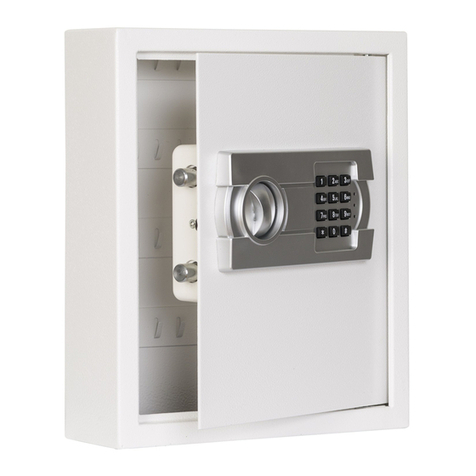
De Raat
De Raat PROTECTOR 40E User manual
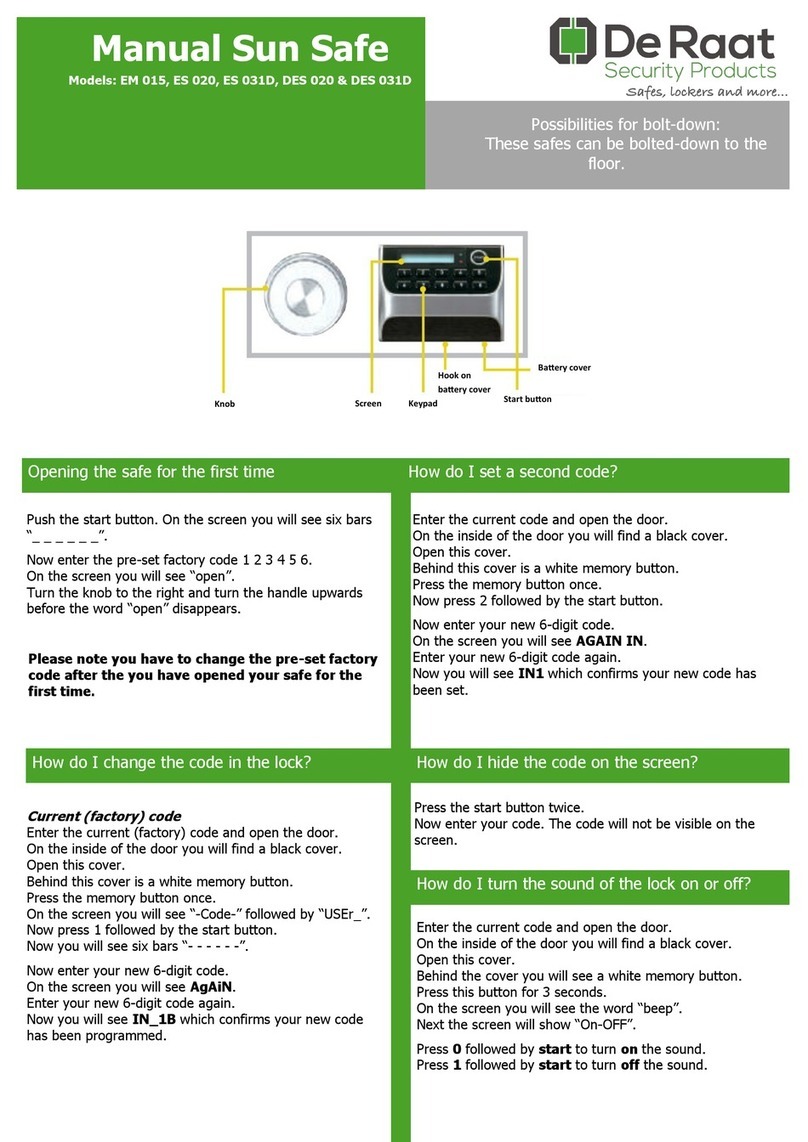
De Raat
De Raat EM 015 User manual
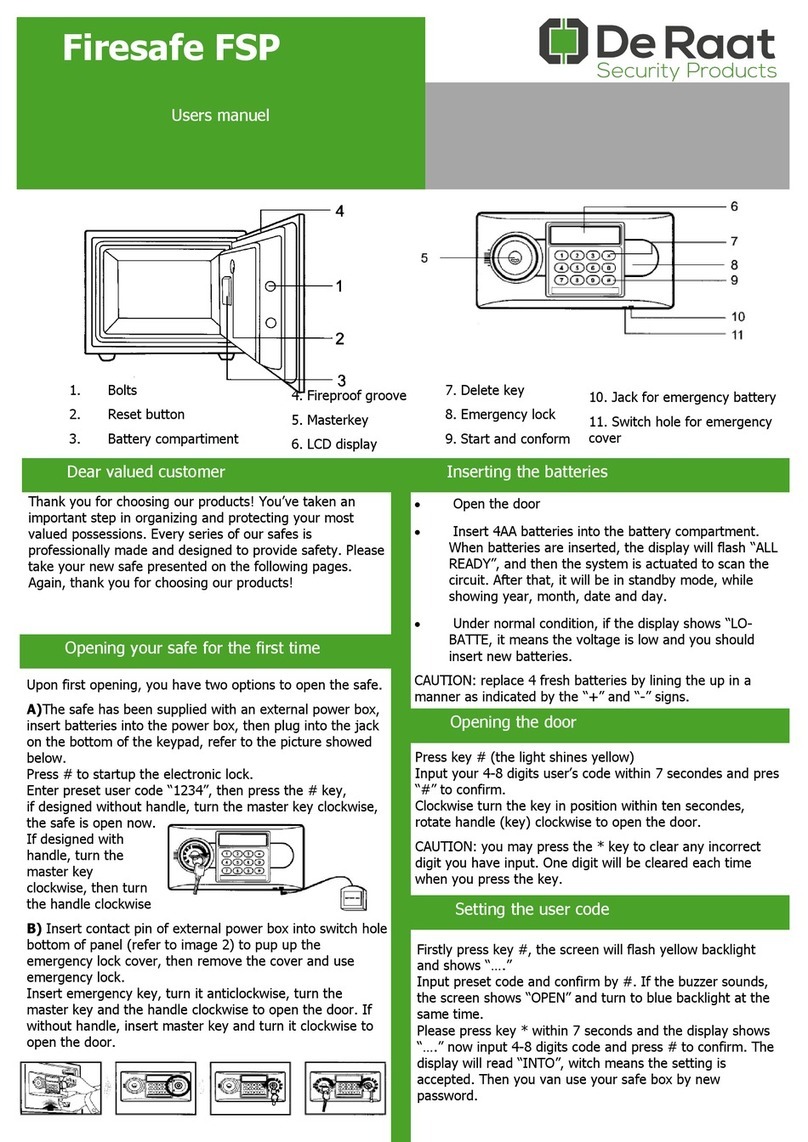
De Raat
De Raat Firesafe FSP User manual

De Raat
De Raat Protector depo cash plus 1 E User manual

De Raat
De Raat Sun Safe ES 045 User manual
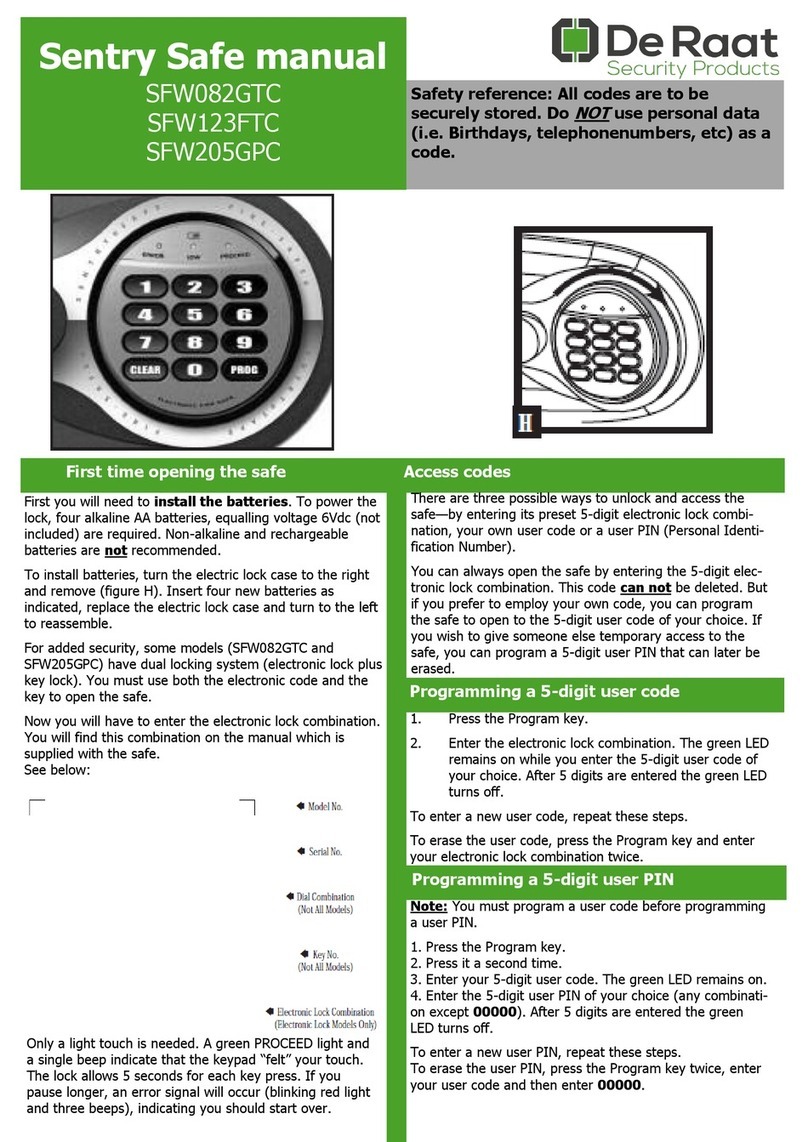
De Raat
De Raat Sentry User manual

De Raat
De Raat VP Safe User manual
